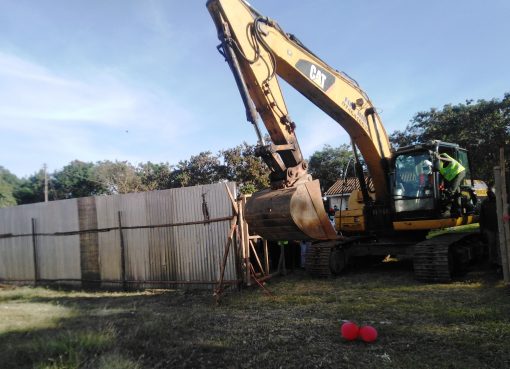Despite an avalanche of warnings and deaths, quarries in Nakuru continue to operate with abandon and impunity.
Sand harvesters at Rhonda quarry in Barut, continue with their daily activities despite the area having been earmarked as dangerous and prone to landslides.
Steven Kipkorir, 22, is a sand harvester whose job is a complex and arduous one that involves him working in deep pits, equipped only with a shovel, crowbar and no protective gear, as he mines sand.
Here hundreds of youth have abandoned schools to engage in sand mining.
Kipkorir says he has seen many around him die when weakened steep walls collapse in the midst of excavation.
“Hunger is what drives us into these sand mines. We earn peanuts here despite the risks we undergo. We excavate sand without safety helmets,” Kipkorir says.
Nakuru town has been voted by the United Nations Human Settlements Programme (U.N.-Habitat) as the fastest-growing town in East and Central Africa.
The new title has resulted in a rush of investors to the area and a subsequent boom in construction industry – the main consumers of sand.
The harvesters excavate sand as deep as 50 feet, opening up sandpits that pose a danger to residents and property.
Harvesting is also done along road reserves and near homes, sparking fears among residents that they could be buried by landslides or swept by floods if the mines are not closed.
David Mosonik, an owner of a two-hectare sand quarry says he has witnessed scores of sand harvesters die when walls collapse on them.
He vividly recalls an incident where a man and his son died when a wall collapsed killing them on the spot, which prompted him to close temporarily.
He says over 3,000 people in Ronda within Nakuru Town West Sub County directly draw their livelihood from sand harvesting.
“These quarries were opened up over 40 years ago. We do not have the capacity to employ those excavating sand on a monthly salary basis since as the owner I have to share the amount earned per seven-ton lorry with all involved. These young men come on daily basis, engage in scooping and loading of sand and get their wage at the end of the day,” Mosonik says.
Mosonik says he charges Sh. 7,000 per seven-ton truck of sand, with 20 percent of that sum being shared among sand miners, loaders and truck drivers as wages.
This year alone, 8 sand harvesters have lost their lives in quarry pits within Ronda with the latest incident happening just last week when 32 year old Sammy Oyoro succumbed to injuries after being buried alive in an avalanche of sand.
Stephano Onyango, a 48 year old father of seven who has been working at a quarry in the area says he has escaped death four times.
The creepiest incident he reminisces was when weak walls collapsed pushing him and a colleague into a shallow pit.
Fortunately they lived to tell their tale.
Mary Tinga, a village elder and Member of Baruti Nyumba Kumi Committee says most unemployed youth have taken to the sand harvesting venture after freshly enforced traffic rules drove them out of Boda Boda business.
“Sand harvesting also poses dangers to locals not involved in the business.
Loose soils pose danger to children and properties.
This grounds shake heavily when heavy trucks drive in or out of the area” explains the elder. We are worried continuous sand harvesting has loosened soils in this area”
The national government she suggests should relax stringent conditions imposed on boda boda operators so that youth can go back to the business.
The County government says Ms Tinga can also alleviate the sand harvesters’ plight by putting in place a conducive environment that will enable more youth venture into hawking and small scale businesses.
Under age children are allegedly involved in some of the worst forms of labour here and some have opted to sneak out of school in favor of sand harvesting, including sand mining.
“The youth engaged in mining are exposed to toxic materials, which increase their chances of developing respiratory diseases.
Others are playing hide and seek with law enforcement agents and opt to miss classes to go of loading sand into trucks to enable them pocket a few shillings.” says another village elder James Amutsama Amunabi.
Interestingly, most sand harvesters who have witnessed firsthand deaths of their colleagues do not consider the work risk.
Eliphas Shakwira, who has been excavating sand for 12 years, says the danger has been blown out of proportion.
He claims that only a few quarry workers resort to dangerous mines to make a living
“The County government should provide standby rescue equipment to deal with disasters when they arise. It should conduct safety training in sand harvesting areas because it takes too long for the evacuation teams to arrive when a disaster is reported,” he says.
The County Commissioner, Joshua Nkanatha, has always ensured temporary closure of the quarries rains begin.
“The management teams must ensure property and lives of each individual are protected.
This is the reason all quarries remain closed during the rain period,” says Nkanatha.
County Environment Director Muriithi Kiogora says a task force has been formed to assess all the quarries and ensure excavators are safe.
In 2015, the National Environmental Management Authority (NEMA) ordered the closure of all sand mines in Nakuru as it emerged that mining was contributing to environmental degradation.
Sand mining in Nakuru, according to NEMA, has contributed to the siltation in River Ndarugu and also poses a threat to nearby public utilities and infrastructure such as roads and schools.
By Anne Mwale.




